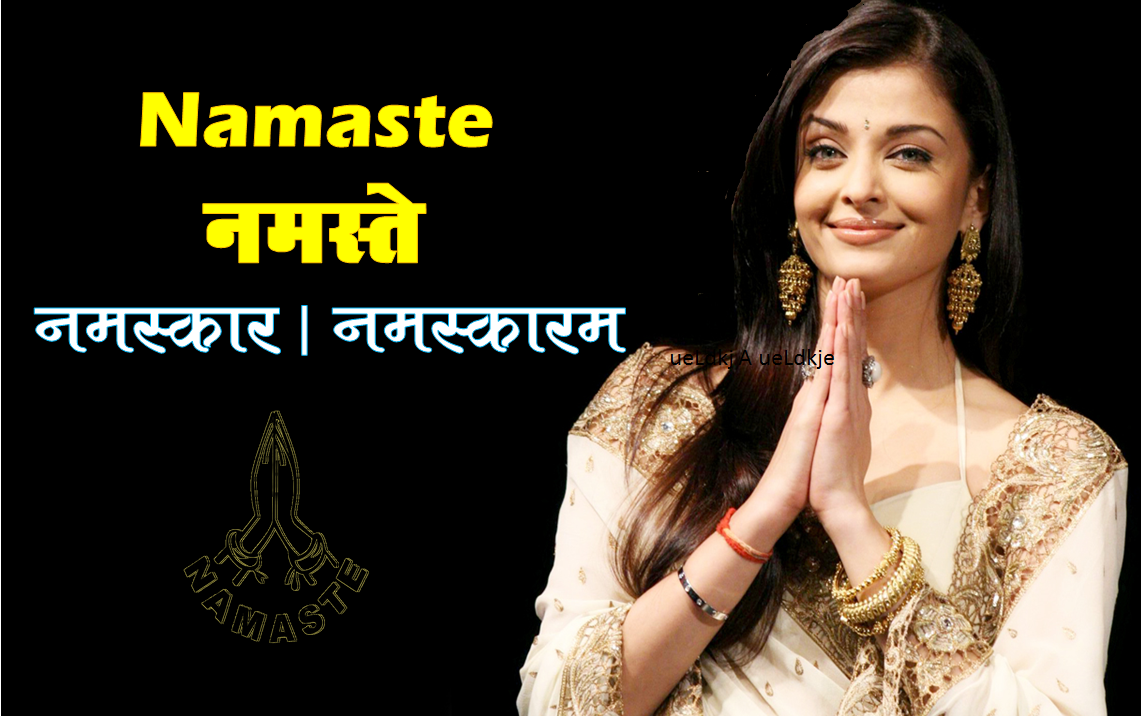Namaste | Namaskar | Namaskaram

Namaste
Namaste is usually spoken with a slight bow and hands pressed together, palms touching and is a respectful form of greeting in Hindu custom, found on the Indian subcontinent mainly in India.
Namaḥ means ‘bow’, ‘obeisance’, ‘reverential salutation’ or ‘adoration’ and te means ‘to you’ Therefore, Namaste literally means “bowing to you”.
It is the traditional greeting in India where the palms of the hands are pressed together in a praying position and held about chest high, then accompanied with a slight forward bow.
The gesture is widely used throughout India, Nepal, parts of Asia, and beyond where people of South and Southeast Asian origins have migrated. Namaste or namaskar is used as a respectful form of greeting, acknowledging, and welcoming a relative, guest, or stranger. It is used with goodbyes as well. In some contexts, Namaste is used by one person to express gratitude for assistance offered or given and to thank the other person for his or her generous kindness.
In the Hindi and Nepalese speaking populations of South Asia, both Namaste (; Devanagari: नमस्ते) and Namaskar are synonymously used. In Nepal, people generally use Namaskar for greeting and respecting their elders. In Kannada, Namaskara (ನಮಸ್ಕಾರ) for singular and Namaskaragalu (ನಮಸ್ಕಾರಗಳು) is used. In Telugu, Namaste is also known as Dandamu (దండము) or namaskaram (నమస్కారం) for singular and Dandaalu or namaskaralu for the plural form. Pranamamu (ప్రణామము) is also used in formal Telugu. In Bengali, the Namaste gesture is expressed as Nōmōshkar (নমস্কার) and said as Prōnäm (Bengali: প্রণাম) informally. In Assamese, Nômôskar (নমস্কাৰ) is used. In Tamil, Namaste is known as Vanakkam (வணக்கம்) which is derived from the root word vanangu (வணங்கு) meaning to bow or to greet.
Often used by Hindus, Muslims, Buddhists, Sikhs, and other religions, Namaste is also used in spiritual circles and yoga classes in the south Asian region. There is something about the universal recognition and the spiritual energy that accompanies the essence of Namaste that makes its truly remarkable greeting.
Just speaking the word Namaste along with the mudra raises the vibration of your intention to greet someone by honoring their inner goodness. Physical contact enhances the ease of flow of subtle energies between two people. With this greeting as there is no physical contact, the ability for one person to affect another negatively is minimized. A Western woman should not initiate a handshake with a man. Most Indian women will shake hands with foreign women, but not men.
Here are two explanations by Aadil Palkhivala and Shiva Reas.
“The gesture Namaste represents the belief that there is a Divine spark within each of us that is located in the heart chakra“. The gesture is an acknowledgment of the soul in one by the soul in another. “Nama” means bow, “as” means I, and “te” means you. Therefore, Namaste literally means “bow me you” or “I bow to you.”

To perform Namaste, we place the hands together at the heart chakra, close the eyes, and bow the head. It can also be done by placing the hands together in front of the third eye, bowing the head, and then bringing the hands down to the heart. This is an especially deep form of respect. Although in the West the word “Namaste” is usually spoken in conjunction with the gesture, in India, it is understood that the gesture itself signifies Namaste, and therefore, it is unnecessary to say the word while bowing.
Suggested Read: Indian Culture






